The People of Manipur
Manipur is an extraordinary place, full of charm, beauty and creativity
- A "flower on the Lofty Heights" is her another name. It lies in the North-Eastern
region of Indian Sub-continent, between 23.5 oN-25.3 oN
Latitude and 93.4 oE-95.3 oE Longitudes, bordering
Myanmar in the east, Nagaland state in the north, Assam and Mizoram in
the west. Encircled by nine hill ranges, Manipur is marked out by a picturesque
valley in the midst. The total area of Manipur is 22,327 sq. km. Out of
this only 2,238 sq. Km are valley while the remaining areas are covered
with hilly tract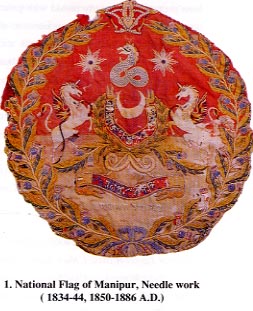 s.
s.
According to the 1991 census report, the total population of Manipur
was 18.26 lakhs but in the 2000 census, it is expected to reach over 22
lakhs (2.2 millions). The people of Manipur are grouped into three main
ethnic communities - Meiteis those inhabiting the valley and 29 major tribes
in the hills dividing into two main ethno-denominations, namely Nagas and
Kuki-Chins. Under the Meiteis, Bamon and Meitei Pangans are also included.
All speak Meiteilon or otherwise known as Manipuri to the outsiders. In
addition to Meiteis, the valley is also inhabited by Nepalis, Bengalis,
Marwaris and other Indian communities. At present several people from the
hill have also migrated and settled in the valley. The Naga group consists
of Zeliangrong (composed of three related tribes, namely, Rongmei or Kabui,
and Liangmei and Zemei or Kacha Nagas), Tangkhul, Mao, Maram, Maring and
Tarao. The Chin-Kuki group consists of Gangte, Hmar, Paite, Thadou, Vaiphei,
Zou, Aimol, Chiru, Koireng, Kom, Anal, Chothe, Lamgang, Koirao, Thangal,
Moyon and Monsang. In recent times, several Chin-Kuki communities
have identified themselves as Nagas e.g. Anal, Kom, Thangal, etc. depending
on socio-economic and geo-political advantages to the tribes. The term
Chin is used for the people in the neighboring Chin state of Myanmar
whereas Chins are called Kukis in the Indian side. Other groups like Paite,
Zou, Gangte, and Vaiphei identify themselves as Zomi and have distanced
themselves from the name, Kuki. Thadous remain the major Kuki population
in this Chin-Kuki group while Hmar identify closer to the Mizo or Lushei
group. 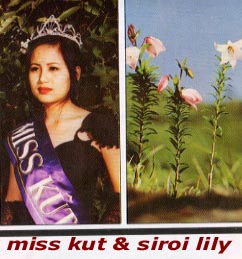
It should be noted that all the different ethnic groups are of the same
Mongoloid group, and have very close similarities in their culture and
traditional habits. The legend of all tribes including Meiteis claim
that they originated somewhere in the north from a cave. The difference
came only in later parts of the history after Meiteis were converted to
Vaishnavism and the hill inhabitants became Christians. Traditional Semantic
rituals resembled very closely. All communities took Yu or rice bear and
were meat consumers. Still the Meitei communities of Chakpa who are
classified as Schedule castes in Manipur, make Yu and eat meat. The Meiteis
believed in scape-goats to cure illness by freeing a chicken away in the
woods just as the Maos and other tribes in the north did. Meitei
men wore long hears similar to the Kuki-Chin group in earlier days and
still some Meitei Marups. In the Meitei martial arts "Thang-Ta', the Ta
(spear) is primarily a Naga weapon although Meiteis developed and perfected
their own war technics and skills in using them. All practices head
hunting at one time of their history. At present, the Meiteis perform
rituals and ceremonies according to the Hindu customs while the hill tribes
perform according to Christian faith. A Bio-Anthropological seroanalysis
of the different ethnic groups of Manipur reveals that all communities
are closely related to the South-East Asian people even the late comers
like Bamons, who intermarried
with the Meiteis.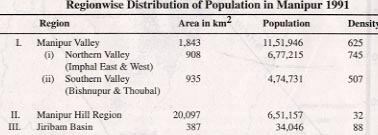
In the last decade, Manipur however has seen a rise in ethnic conflicts.
In early 1990s Meitei-Pangan had a major clash for the first time in their
history (influenced by Hindu-Muslim analogy in Indian states), then
erupted the Naga-Kuki followed by Kuki-Paite conflicts. There is
also some volcanic rumbling between Meiteis and Tangkhuls and some Naga
tribes on the issue of Manipur territorial integrity. This is a complex
political issue. Nevertheless, a brief undertanding of the development
of socio-political situations leading to that prevailing in Today's Manipur
may help to bring out a future peaceful co-existence of all ethnic
peoples of this beautiful land.
The Meiteis, who are made up of seven tribes or clans from early centuries
(even before the Christ era) ruled Manipur continuously under various names
since the time of Nongda Lairen Pakhangba (33 AD-154 AD). This continued
until 1955 AD with Budhachandra Maharaja. The kingdom of Manipur
was conquered by the British in 1891 AD at the battle of Khongjom and ruled
as a protected Kingdom. Manipur regained its independence along with India
in August 1947, but on October 15, 1949, the King signed a Merger agreement
with India at Shillong, the legality of which is still in dispute. Before
the British came, the people of the valley and the hill interacted among
themselves and depended on each other for their needs though at times turbulent
and other times peaceful. During the 7 years of the Burmese occupation
in Manipur (1819-1925 AD), the Meiteis ran to the Tangkhuls and Kabuis
in the hills and many were absorbed within them. Several Kabuis settled
in the valley and even accepted Hindu customs along with the Meiteis. But,
during the expansion of the British Empire towards the North East
frontier from India, the uncharted tribes of the Tuensang hills, which
the British also called collectively Nagas, frequently fought with
them. The Meitei kings sided with the British instead of helping the native
tribes in an exchange for protection against the invading larger
Burmese armies. When the Government of India and the Northern Naga tribes
reached an agreement to form the Nagaland state in 1963, several tribes,
who were under the Meitei King since historical times and within
the Manipur territory under the Indian dominion were not included. A strong
affinity for Naga identification and a Christian Unity evolved among the
different tribes of Manipur and wanted to join Nagaland. However,
they are closer to the Meiteis geographically and economically, and most
of them are more closely related to Meiteis ethnically. However,
the religious alliance and Meitei supremacy was a big factor. After the
conversion of Meiteis to Hinduism, the valley people treated the hill tribes
as untouchables and called them "Hao" a derogatory meaning "uncivilized".
This led to a creation of a gigantic barrier between the hill and valley
people - one accepted Hinduism and the other Christianity. Among
the Meiteis themselves, there were Lois or Yaithibis, who were driven out
of the Meitei community to far villages as untachables by the Maharaja,
for they did not accept Hinduism. Also, the Imphal Meiteis call other Meiteis
of villages and towns as "Lawais" or "uncivilized".
The Chin-Kuki tribes were of comparatively late migrators (as late as
the 18th-19th century) to Manipur from the Chin state of Burma compared
to other communities in the north and central Manipur. Unable to handle
the flux of the large migrants, the Meitei Maharaja with the help of the
British assisted the Thadous and other Chin-Kukis settle in different parts
of the hills, which were not inhabited at that time, although claimed by
local tribes as their territories. The population of Manipur was
very sparse in those days. Therefore, Thadous live in many districts of
Manipur while Naga tribes have their own territories marked clearly even
though inter-tribal territorial disputes existed amongst themselves.
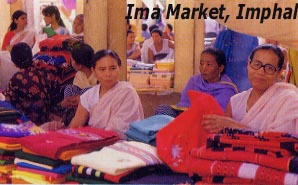 Among the Naga
tribes of Manipur, the Tangkhuls were the first to recieve Christianity;
therefore, they were more educated and better adapted to the modern and
Western cultures than other tribes. Naturally, they became leaders and
helped to stablish schools and churches, not only in Manipur hills but
also in Kohima, Makokchung, and Dimapur in Nagaland state. Although the
various tribes in the north of Imphal Valley are grouped together under
a Naga denomination, they have different languages and customs. Therefore,
they also had political mistrusts among themselves while they were
bound together by a common faith in Christianity. The Tangkhuls dominated
in various aspects of the Naga political and social fronts. This led to
certain anti-Tangkhul sentiments in Kohima, Dimapur and Makokchung areas
in Nagaland, and tried to drive them out of Nagaland state in mid 1990s.
In addition, the Angami and Ao tribes always considered the Nagas of Manipur
inferior to them in their territories specially in Kohima. This led to
a demand for Southern Nagaland by some Manipur tribes. Several Naga NGOs
try to bring all tribes under the Naga denomination together. But the Angamies
and the Aos of Kohima, Makokchung and other tribes of Tuensang
were skeptical about the movement and were afraid that the Tangkhuls of
Manipur may dominate the Nagaland (Kohima) politics if they come to their
side.
Among the Naga
tribes of Manipur, the Tangkhuls were the first to recieve Christianity;
therefore, they were more educated and better adapted to the modern and
Western cultures than other tribes. Naturally, they became leaders and
helped to stablish schools and churches, not only in Manipur hills but
also in Kohima, Makokchung, and Dimapur in Nagaland state. Although the
various tribes in the north of Imphal Valley are grouped together under
a Naga denomination, they have different languages and customs. Therefore,
they also had political mistrusts among themselves while they were
bound together by a common faith in Christianity. The Tangkhuls dominated
in various aspects of the Naga political and social fronts. This led to
certain anti-Tangkhul sentiments in Kohima, Dimapur and Makokchung areas
in Nagaland, and tried to drive them out of Nagaland state in mid 1990s.
In addition, the Angami and Ao tribes always considered the Nagas of Manipur
inferior to them in their territories specially in Kohima. This led to
a demand for Southern Nagaland by some Manipur tribes. Several Naga NGOs
try to bring all tribes under the Naga denomination together. But the Angamies
and the Aos of Kohima, Makokchung and other tribes of Tuensang
were skeptical about the movement and were afraid that the Tangkhuls of
Manipur may dominate the Nagaland (Kohima) politics if they come to their
side.
In the meanwhile, due to population pressure and a scarcity of cultivable
land in the hills of Manipur - topped with historical rival between
the Naga tribes and Kukis on their settlement in Manipur, but not in Nagaland
- an ethnic conflict between them erupted. The Thadou Kukis were
surrounded in their villages by Naga villages in most districts except
in Churachandpur in the South. They migrated in large numbers to
Churachandpur, which is dominated by the majority Paite tribe and by a
large population of Thadou Kukis as well. This further led to the
Paite-Kuki conflict, which was later reconciled under signed accords by
both sides. At the same time, several Naga groups demanded that all
Naga inhabited areas of Manipur should be integrated to Nagaland, which
was not accepted by the Meiteis and other groups. This issue was considered
to be a brain-child of the Tangkhuls by the Meiteis - hence a conflict
between the Meiteis and the Tangkhuls began to develop leading to Manipur
territorial integreity rallies at Imphal. Whatever be the reasons,
political motives or correctness to all communities, the peoples of Manipur
are of the same origin and their traditions are related to each other regardless
of their denominations and should be able to live together harmoniously.
The younger generations of Manipur are well educated and aware of keeping
faith to each other. They believe in peaceful co-existence for all ethnic
groups and an economic development for Manipur and its people. 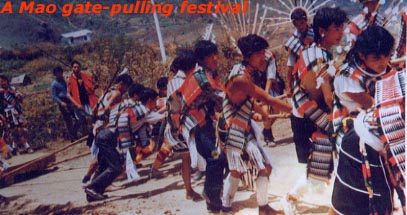
One needs to examine the different communities of Manipur individually
in order to bring out an understanding and to start a meaningful dialogue
among themselves. The communities of Manipur in alphabetical order are:
Aimol, Anal, Chiru, Chothe, Gangte, Hmar, Koirao, Koireng,
Kom, Lamgang, Mao, Maram, Maring, Meitei, Monsang, Moyon, Paite, Tangkhul,
Tarao, Thadou, Vaiphei, Zeliangrong (Zemei, Liangmei, Rongmei) and Zou.
In addition, Nepali, Bengali, Marwari and other Indian communities have
also settled in the valley. All tribes have their own distinct languages
but in conversing with others they speak Meiteilon. Rice is the staple
food for all ethnic groups of Manipur and meat, fish and seasonal vegetables
are favorites. Meiteis prefer fish and elders usually do not take meat.
Aimol: The aimols are a scheduled tribe of Manipur.
They settled at Aimol Khullen at Chandel District and at Kha-Aimol
near Loktak lake and other places in the Senapati district. According to
the 1981 census, they number about 1062 individuals. It is also believed
that some migrated in Mizoram and Tripura. The word aimol means "mountain
of crabs" (ai=crab; mol=mountain). Thus, their legend believes that they
came out of mountain like the mountain crabs. They practice both wet and
shifting paddy cultivation in the hill. Some of the crops other than paddy
are sesamum, maize, soyabean, pumpkin, gourd, ginger, tomato, chilly and
groundnut. They domesticate mithun (water buffalo), pig, ox, chicken,
etc. Kakching and Pallel are the two important towns for marketing and
trading. Most of the Aimols are now converted to Christianity and identify
with the Nagas although they may be related to the Chin-Kuki group. Due
to close proximity, they are also directly influenced by the Meiteis.
Anal: The Anals are also a scheduled tribe settled in the
Southern Manipur hills at Tengnoupal district. They are known as Pakan
among themselves. During migration, they were splitted to Anal, Lamkang,
Moyon, and Monsang tribes. Anal is considered to be one of the oldest Chin-Kuki
tribes of Manipur and belong to the Tibeto-Burman family of tribes. They
now identify themselves as one of the Naga tribes. In 1981, their population
was 9,349 living in 45 villages. A pregnant woman in the Anal community
do not work hard and the husband is taboo from planting banana or
bamboo trees. She may not eat double bananas or any creepy plants
that bear fruits. Their cultural life is rich and preserved in traditional
folklores and folksongs. The festivals include "Akam" performed to invoke
divine blessings. Kamdon dance is performed during the Akam festival both
by man and woman.
Chiru: They are concentrated in Senapati, Tamenglong and Bishnupur
districts of Manipur. Their manners, customs, and language appear to identify
with Kuki origin but their physicque, habits, hairstyle, and bachelors'
quarters are Naga way of life. The word Chiru means the seed of a plant.
Women play an important role in agricultural work, collection of firewood,
and fetching water for drinking and household uses. They practise both
shifting and wet cultivation. Fruits like banana, orange, lemon, and papaya
are grown for family consumption and market trading. The main cottage industries
are basket and cane works, weaving, carpentary and manufacture of musical
instruments. Their numbers are about 3,744 persons (1981 sensus).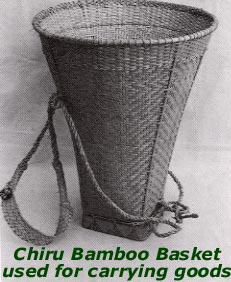
Chothe: Historians describe the Chothe as Purums as they settled
at a place called Purum in Chandel District. The term Chothe derives
from Kachohte meaning to bring or to hold a boy. They settle mostly in
10 villages in Chandel district and their number was approximately 1,607
in 1981. Agriculture is their main occupation, and they grow cash
crops which are sold in Pallel, Tengnoupal, Kakching and Imphal. The main
festival of the Chothe is Harvesting festival (sasuhang) along with Christmas,
New Year, Good Friday, etc. Dance and Music are thier cultual life both
in religious and recreational events. Inter-marriage with neighboring Nagas
have made good alliances with them and they identify themselves with the
Nagas.
Gangte: The Gangtes numbered about 7,891 in 1981. The Paite,
Vaiphei and Thadou call them Gangte but Mizos call them Rangte. Their origin
is traced in a cave called khul somewhere in the extreme north.
They settle mostly in the Southern part of Churachandpur district. Apeasement
of the village deity was an annual feature before they converted to Christianity.
They share folksongs, folktales and dances with other communities like
Paite, Zou, Thadou, Vaiphei and vice versa.
Hmar: According to 1981 census, the Hmars had a population of
29,216 in 35 villages in the southern region of Manipur, at Tipaimukh and
Churachandpur. They speak Hmar language and converse well in Meiteilon.
They also have populations in Cachar, North Cachar and Aizwal district
of Mizoram. They are one of the highly educated Christian communities
of Manipur tribes. They enjoy zu, home brewed rice bear, but Christianity
has restricted it and replaced with tea in rituals. Earlier Hmars worshiped
spirits, the mountains, the rocks and rivers. The first Christian missionary
to the Souther Manipur, Watkin Roberts of Wales arrived in 1916 in a Hmar
village at Senvon.
Koirao: Koiraos inhabit the mountain ranges in the south of the
Mao and Maram but they accept themselves by the name Thangal. They
are concentrated in the Sadar hills of Senapati district. Their population
was just 919 in 1981 census. It is said that Maharaja
Pamheiba of Manipur (Garib niwaz) was a Thangal boy or was brought up within
the tribe. They believe that children are a gift of God and the village
maibi will pronounce the birth of a child by saying Haiguiye while
holding a dagger in her hand. In earlier days, they bartered their agricultural
products, baskets and blacksmithy with Meiteis for food, with Tangkhuls
for earthern pots and with Kukis for beaded necklaces. Khullakpa is the
chief of the village council known as katammi. Favorite festival
is Linhut tangnit (Seed sowing festival), along with Christian festivals.
Koireng: The Koirengs believe that they originated from
a cave. Pathian is believed to be their supreme God before Christianity.
They live in small villlages on the hills to the north of Imphal valley
in Senapati district. Imphal, Iril, and Maklang rivers run through thier
villages. The status of women is relatively high due to their taking part
in economic activities. A woman member is also represented in the village
council. They cultivate paddy, maize, sesame, potato, arum and ginger
and traded with the Meiteis. Their number is small (918 in 1981 census)
and literacy rates are low compared to the surrounding tribes.
Kom: The Koms believe that thier ancestors came out of a hole
in the earth or Kom. Their population was 9,830 in 1981 census in 22 villages.
Most of the villages are scattered in the Churachandpur, Tengnoupal and
Senapati districts. Their language is to an extent recognised by the Aimol,
Koireng and Chiru. They also have close relationship with the Hmar. The
Koms are easily identified by their way of dressing. They wear a black
shawl embroidered in the border. Koms believe in Pathen, the supreme god
and goddess, Lengjai. They are omnipresent and believe to live in the heaven.
The literacy rate is quite high and they actively perticipate in political
activities of the state.
Langang: The Lamgang dialect is quite similar to Anal, Moyon
and Monsang of the Kuki-Chin group of languages of the Tibeto-Burman family.
They speak Meiteilon while talking to others. They address themselves as
Kasen. Hiroi Lamgang was a Meitei name used to address them for they made
boat (hi) for the Meitei kings. They settle mostly in the Southern districts
of Manipur near Chakpikarong, Kakching Khunou and scatter in 24 villages.
They number is about 3,452 according to 1981 census. They still lag behind
literacy comared to Moyon, Monsang and other tribes.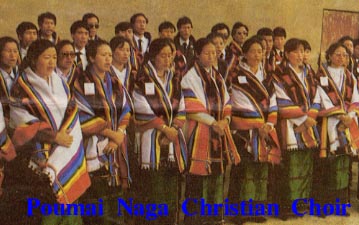
Mao: The Maos inhibit the hill ranges to the extreme north
of Manipur on Highway 39. The Mao as such is the village or
place and the people are Maomei or Imemei. The Angamis of Kohima call them
as Shipfumei. The literacy rate among tribes in the Mao area are
high. They actively participate in politics at Imphal and several
professionals, doctors and engineers come out of this tribe. Their
population was 50,715 in 1981 census. Majority are agriculturists and cultivate
terraced paddy fields. They rear cows, buffallos, pigs, fowls, etc. At
present the regional potato farm is located at Mao and assists the nearby
villages in growing more potato through modern technics. Mao is also a
commercial center and station for Tourists, buses, and commercial
trucks plying through the Imphal-Dimapur road. The Mao areas have better
communication and electrity.
Maram: They numbered about 16,544 in 1981 scattered in
22 villages in the Senapati District. They call themselves Maram-mei (people
of Maram). The Barak river runs through their territory. They have close
similarity with the Maos, Angami and Koireng and use the same designs and
color combinations of shawls. The community is exogamous and marriage within
the community was not allowed. They intermarry with the Mao, Angami, Zeliangrong,
Paomei, Thangal and other Naga groups
Maring: The Marings had a population of 11, 910 (1981 census)
in hilly villages in the Tengnoupal subdivision in Chandel bordering Myanmar.
It is said that they had close relationship with the Meitei Kings and their
name derived from mei (fire) and ring (start or produce). Meitei
kings depended on them during wars with neighbors. There are three mains
groups of Marings who identify themselves with different colors in their
clothings: Black, Red, and Red and Black on the border. The village of
Machi is regarded as their original place, which is the center of the Black
Marings. Their language is closer to the Kuki-Chin branch of Tibeto-Burman
family although they are affiliated to the Nagas. They also have many Meitei
words used by them. In one time, Haobam Marak of Imphal was considered
to be the settlement of the Marings. The infrastructure in Maring villages
are rudimenatry, and are economically weak. However, they are educational
enthusists. They participate actively in the State politics. If provided
adequate road and communication infrastructure, they will be a very
progressive group of tribes.
Meiteis: The Meiteis are distributed throughout the Manipur valley.
By rule, any Meitei is not allowed to own land in the hills while the people
of the hill can live anywhere in Manipur. The Meiteis make up about 60%
of the total population of Manipur. Among the Meitei-fold are included
the Bamons (Brahmins), Pangans (muslims), and other schedule caste groups
like the Chakpas (previously called lois) and Thoubal Khunous (previously,
Yaithibis). While the Bamons and Meiteis are Hindu Vaishnavites, Chakpas
and other scheduled Meiteis follow traditional Meitei faith. A large number
of Meiteis also follow the traditional Sanamahi religion at present after
the revival of the old Sannamahi faith. Even the Bamons and Hindu Meiteis
worship Sanamahi inside their houses. The Vaishnavite culture of Meiteis
and the Ras Lila Dance is known widely in India and other countries.
In addition, Lai Haraoba and Khamba Thoibi Dances are also popular. The
modern game of Polo is originated in Manipur and locally known as Sagol
Kangjei (horse hockey). Meitei Martial arts - Thang Ta - has recently been
recognised as one of the forms of International Maritial arts by
the International Martial communities. Since Meiteis are the dominant community,
culturally and economically, Meiteilon (Meitei language) has become to
be known as Manipuri after the name Manipur was introduced in the elsewhile
Kangleipak, Sannaleipak (Land of Sannamahi, not Golden land), Meitrabak,
etc. However, Meiteis randomly refer the word Manipuri among themselves.
Manipuri should reserved for all things associated with the state of Manipur,
not only of the Meitei.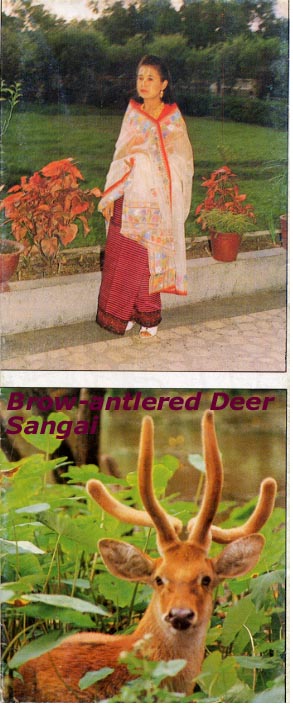
The Meiteis are also primarily agriculturalists. Rice is the staple
food. Fish is a favorite meat for Hindu Meiteis. But, the younger generation
tastes all kinds of meat available in the market. Fruits such as pineapple,
mango, orange, lemon, guava, jackfruit are also cultivated. Produces like
peas, potatoes, cabbage, cauliflower, carrot, etc. are abundant. The Meitei
women control the markets and trades for traditional clothings and vegetables.
Ima Market or Kwairamban Keithel is an exclusively Women's market of its
own kind. The women also take important roles in safeguarding the
communities and their children. They were effective in blocking alcohol
consumption by men through Meira Paibi Organisations. But, with the society
becoming more complex, the traditional role of the women are waning. They
have not been able to stop the drug addiction of youths in Manipur. The
jobless youth both in the valley and hills are taking up the habit of injecting
drugs, heroin, chiefly available through the Myanmar border trafficking.
This has caused alarmingly high number HIV-infection cases, already full-blown
AIDS related deaths have been reported. Subsequently, it has spread to
innocent wives and childrens through marriages. Manipur has one of the
highest rates of HIV infection in India. No mentionable industry is found
at Imphal, the capital city of Manipur or any other towns.
Monsang: The name Monsang is derived from the name of the village
called Mosang by the Meiteis and others whereas they themselves called
sirti or southerners. They live mostly in the Chandel District in
five villages namely Liwachaning, Heibunglok, Liwa Sarei, Japhou, and Monsang
Pantha. They speak a similar language with the Anals. They use Meiteilon
while conversing with Tangkhul, Maring, Thadou and other communities.
The Monsangs come in regular contact with other communities through economic
activities maninly at Pallel, Kakching, and Chandel and Imphal. Monsang
parents attach great importance to education. Their population was
about 1,139 in 1981 census. In 1920, they joined Christianity.
Moyon: The Moyon themselves are known as Bujuur. Their legend
indicates that they originated from a cave located at Sijjur. They live
in 14 villages in Chandel district and their name derives from one of the
villages called Moyon Khullen. Their name is found in the royal Chronicles
as far as 1580 AD such as Mongyamba's time. The Meitei King defeated the
Moyon Chiefs and he was known as Moyon Ngamba or Mongyamba. Their population
was 1,642 in 1981 census. Marriage is by negotiation (luhong) or elopement
(itaen). Their sowing festival is known as Sachii ichii and harvest
festival is Buren Iimpeh. They also believe that they originated
from a cave, known as Khur or Khul. The Moyons attach considerable importance
to education and every village has at one primary school. They converse
and read Meiteilon (Manipuri) very well.
Paite: They live in Churachandpur district in Southern
Manipur. Along with Thadou, Vaiphei, Gangte, Hmar and others they were
refered to as Chin-Kuki group in the past. At present, they call themselves
as Paite and affiliate to Zomi denomination. They also believed in supreme
god Pathian and believed to have originated from a cave or Khul. Their
population was 30,959 in 1981 sensus spreading over 125 villages. Jhum
cultivation is their main occupation on the slopes near the villages. Folksongs
and folktales related to everyday life and culture of the poeple are orally
passed through generations. They are an educated group of tribes and participate
actively in local and state politics.
Tangkhul: They live in the Ukhrul district in the east.
According to their legend, two groups led by two brothers went out to seek
suitable places for settlement. Naokhoka, the brave elder brother, led
his people to south-east while the younger brother found the fertile plains
and settled there, which later came to be known as the Manipur Valley.
They believe they migrated from Mekhel village in Senapati destrict like
other Naga tribes. Another popular legend also relate to their origin
and the Meiteis. According to this legend, a sow belonging to two
Tangkhul brothers of Hundung village wandered away. The Younger brother
found it in a valley near the bank of Iril River and settled there. His
brother remained in Hundung and maintained a close relationship. They exchanged
gifts and novelties made in their respective areas. However, the younger
brother, having accumulated a lot of wealth discontinued the exchange of
gifts. The elder felt neglected and insulted. He raided the village in
the plains to take by force what he had till now been receiving as presents.
The Tangkhuls numbered 71,203 in 1981 census and formed about 5.01 percent
of the total population of Manipur. They live in 8 territorial areas in
the Ukhrul district and their sub-tribes and nationalities have distinct
languages and dialects. Since the Ukhrul village was chosen by the first
Christian Missionary in Manipur in 1896 for conversion, the poeple of Ukhrul
town dominates the Tangkhuls and their dialect is a lingua franca among
the various Tangkhul tribes. They converse well in Meiteilon with others.
They use Roman script for writing. They are the most educated tribe of
Manipur. Several Chief Ministers and Ministers in the Assembly of Manipur
State had belonged to Tangkhuls. Indian Administrative Services (IAS) officers,
Doctors, Engineers, Professors and all works of life are quite developed
among the Tangkhuls. They are also leaders in Baptist Church Activities
of Manipur. Next to the Meiteis, the Tangkhuls have the highest number
of professionals in Manipur. Like most other communities in Manipur, most
Tangkhuls are also primarily argriculturists. Rice is the staple food.
Other crops and vegetables are cotton, millet, maize, arum, chilli, sesame,
ginger, tomato, pumpkin, cucumber, beans, etc. Siroi Kashong famous for
Siroi Lily and Kangkhui cave are in the Ukhul district. During the world
war II, the Japanese occupied the Tangkhul areas in the invasion of Imphal.
At present, a large number Tangkhul have settled at Imphal mostly
from the upper class group who work for the Government.
Tarao: They are a minor community in the Chandel district. They
speak Taraotrong but speak Meiteilon well with others. The Taraos were
also referred to as Kuki in earlier ethnographic studies but now they identify
with the Nagas. It is said that Maharaja Chingthang Khomba had an orchard
at a place near Pallel and his orange trees were looked after by the Taraos
at Komlathabi. They are concentrated at four villages. They are involved
in planting fruits like banana, lemon, pineapple, papaya, etc. Their land
is considered to be the driest place in Manipur.
Thadou: The Thadou are a schedule tribe of Manipur. They are
classifed as an Old Kuki Group by anthropologists. Their communities are
dispersed in several districts of Manipur. According to the 1981 census
their population was 70,126 and formed about 4.93 percent of the total
population of Manipur. The history of this community is found in oral traditions
including folklore and folktales. Their origin traces like other tribes
of Manipur to a cave at the origin of Gunn river (Imphal river). They can
be identified by the traditional design of the shawls, which are marked
in black with a few stripes of red. The design is simple and devoid of
any geometrical figures. They speak Thadou language and converse in Meiteilon
with others. The Thadous are non-vegetarians and fond of drinking
zu made from rice or maize. However, Christianity has prevented from taking
liquor and gradually replaced with tea. The price of a bride is taken in
the form of Mithun, gongs, beads and necklaces, though not practise anymore.
Marriage is through negotiation known as Neila. The groom arrives
at the brides residence along with his associates, followed by a feast.
Basketary, poultry, weaving, and cane work are the traditional crafts of
the Thadous. Although agriculture is the main occupation of many Thadous,
the younger generation have taken up jobs in professional fields in the
Government services, teaching, etc. They participate actively in local
and state politics. Several Ministerial positions are held from this tribe
in the Manipur State Assembly.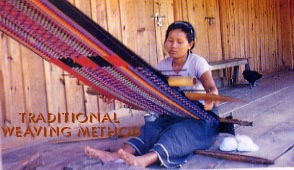
Vaiphei: They live in the Churachandpur district in about 30
villages (population 14,659 in 1981 census). Their dialect is Vaiphei and
slightly different from the Gangte, Zou and Paite. Their speech is closer
to Gangte but spell similar to Paite. They use Roman characters. The major
economic source is the jhum cultivation from paddy and depend on forest
products. They live in one of the highest literature and education areas
in Manipur.
Zeliangrong: The Zeliangrong is a composite group of three
related tribes inhabiting in the Tamenglong district of Western Manipur.
The three groups are Rongmei (Kabuis), Liangmei and Zemei (also called
Kacha Nagas). Many Kabui villages are also found in the plains of Manipur,
Assam and few settlements in Nagaland. According to 1981 census they numbered
about 47,266. Their legend also believe that they came out of a cave, which
was blocked by a big stone and later removed by a mithun. The "Kabui" word
is considered to be a corruption of Apui meaning mother, which they
worship as goddess, Leimaren. They speak Meitei language well and
had close interactions with the Meiteis of the plains. The Kabui is divided
into four exogamous clans: Kammei, Gangmei, Langmei and Ganmei.
The main occupation is cultivation and paractise jhum system in the hills
and wet cultivation in the plains. Some of their crops are maize, soyabean,
pumpkin, gourd, ginger, tomato chilli and groundnut. Carpentary, weaving,
basketary are cottage industries. They are considered to be one of the
most skill crafts men of Manipur. The plain Kabuis have considerable influence
of the Vaishnavite tradition and Meitei culture. Facilities of education,
medical care, and employment programs have reach them well and their population
consists of scholars, administrators, teachers, doctors, nurses, entrepreneurs,
etc. They are also actively involved in the political scene in Manipur.
After the formation of the Zeliangrong community of the North East India,
they constitute a powerful lobbying community. They prefer Zeliangrong
than Kabui or Kacha Naga.
The Zemi (Zemei) and Liangmei are separated by rivers and mountain barriers
and their dialects are different from one another. Meiteilon is the lingua
franca of the people and they use Roman character. According to their
believe the supreme god (Charawang) created the universe and gave
human beings shelter in the caves. Pokrei (a male) and Dichalu
(a female) gave birth to four sons. Their sons and descendents form the
Liangmei, Anpuimei, Zemei, Maram, Rongmei, Tangkhul and Meitei. The history
of Manipur reveals that the Zeliangrongs had a close relationship with
the Meiteis. During the Burmese invasion, the Meiteis of the Imphal valley
left their homes and took shelter in Zeliangrong areas. Politically they
are active and the "Zeliangrong movement of the 1927-32" led by Jadonang
and Rani Gaidinliu is well celebrated among the Zeliangrongs. Road communication
to Tamenglong, their headquarter is very poor. The villagers plant potato,
giner, pineapple etc. and cane and bamboo works are their main crafts.
Zou: Zous live close to the Paites and have close similarities.
They share many oral traditions, folklore, dance and music with Paites.
They also claim to have originated from a cave or khul somewhere
in the extreme north. Their number is about 11,251 in 1981. The village
administration is at the hands of the village chief. Their economy is low
and mostly depend on agriculture and labor for small wages.
Sources:
1. People of India, Manipur, editors M. Horam and S.H.M. Rizvi (1998).
2. Cane and Bamboo Crafts of Manipur, by Mutum Bahadur (1994).
3. Queen Empress vs. Tikendrajit Prince of Manipur, by John and Saroj
Arambam Parrat (1992).
4. An Approach to the History of Meiteis and Thais, by K.C. Tensuba
(1993).
5. Journal of the Geographical Society of Manipur, edited by Dr. A.
Lalit Singh (July-Dec. 1997).
6. Manipur Tourism Department Bulletins.
7. Traditional Textiles Of Manipur by Mutua Bahadur (1997)
Comments to: pukhramba@hotmail.com